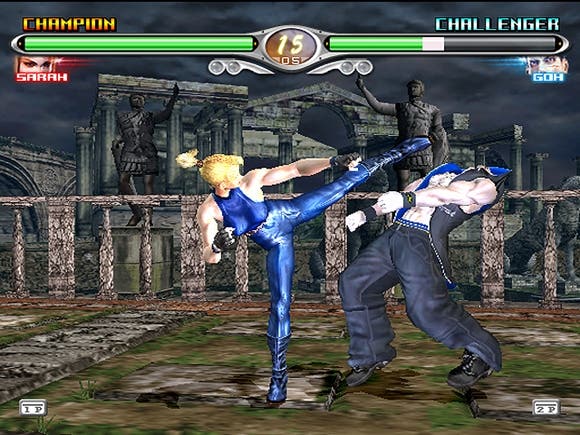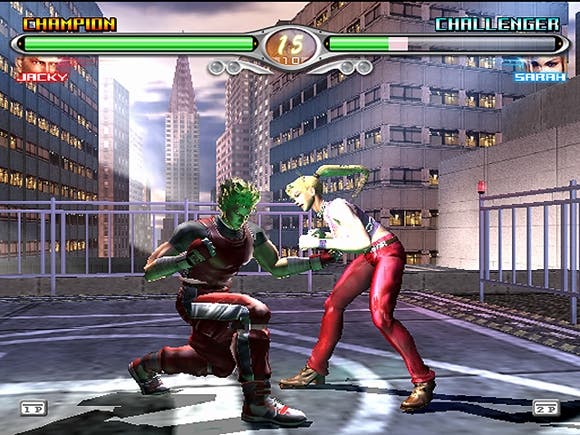Virtua Fighter 4 Evolution
Best beat 'em up ever or rip-off scam?
Evolution. Isn't that what most game sequels are these days? Ever since the days of the 4,000 Street Fighter II editions, cash cow franchises have been milked to the very last rancid drop, and thanks to the unwavering loyalty that hardcore gamers possess games companies know only too well that plenty of people would buy the same game about four times if it came in a different box. Dare we assume Virtua Fighter 4 Evolution will offer enough 'new' content to justify the £39.99 price tag?
Rip off Britain?

Well, before we get on to the issue of new content, let's look at the thorny problem of pricing for a moment. You see, £40 for a hardcore update is probably over and above what most people would pay for an absolute killer app, never mind an update. But it's only when you realise that stateside gamers are being asked the equivalent of around £13 for VF4 Evo that we really have to throw our toys out of the pram. Yes, that's right, Brits pay the equivalent of $67, and US gamers pay just over $20 (including taxes). Something's rotten in the state of PAL-gaming land.
Justified pricing rants aside, VF4 Evo is a game you'll either cherish to your bosom like a naughty runaway puppy, or kick out in the coal cellar, chastised for making an unholy noise for no good reason.
"So what's new?" you're probably vaguely curious to know. No jaggies, two new fighters, new moves, 1,500 costume customisation items and the Quest mode as a replacement for the Kumite mode. "That all?" 'Fraid so.
Making amends

On the visual front, many of you would rightly point out that last year's VF4 was an archetypal demonstration of PS2 developers' inability to come to terms with the tricky architecture, full of harsh jaggies and that irritating 'shimmer'.
Given that Sega was still coming to terms with alien hardware, it wasn't surprising the VF4 didn't quite live up to its potential, but this time around, it appears that AM2 has finally sussed out the innards of Sony's machine and done the game's luscious visuals justice. Although still not quite up to the standard of Dead or Alive 3 on the Xbox, they're certainly up there with the best we've seen on the PS2, sporting some superbly fluid animation, improved lighting and backdrops full of incidental detail. In some cases the backdrops have changed in subtle ways, but you'd need to be a real fan to be notice such small details.
The two new characters in the game are Goh the Judoka (an obscure Judo master) and Brad the "ferocious Muay Thai Kick Boxer". Goh has already gone down well with the game's aficionados for being one of the more powerful fighters out of the 15. Keen-eyed observers will also note that the original characters moves have been rejigged, with some added and some taken away.
Although this meddling with the combat engine has said to have helped hone and refine the experience somewhat, unless you're an absolute hardcore VF nutter, you're probably not going to spot whether character X's jumping knee attack has been replaced with a groin kick. Whatever, from our experience with the game, the controls are among the slickest, most responsive and well judged we've ever come across in a beat 'em up. On any level, though, it's easy to see that there's an oceanic depth to the combat engine that becomes more apparent the more hours you invest in the game.
A quest to be good at beating your face to a pulp

Meanwhile the new Quest mode helps hone your skills better than the old Kumite system ever did, offering up much more 'human' and therefore realistic AI opponents that have been based on real VF players' fighting styles. Whereas in the past, the only way to get really good at games like this was to play your mates, VF4 Evo offers you a means of becoming an elite killing machine even without human opposition. But again, unless you're really proficient at the game, this may well be lost on you - although it's still good fun. The actual basis for the Quest mode has you fighting through a series of simulated Arcade tournaments, and in many respects is more fun than the main Arcade mode. For beginners it's a much gentler introduction to the game to go for the Quest mode, rather than head for the feisty Arcade mode. Although we cracked the 10-stage Arcade mode within about 20 minutes on Normal difficulty level, the latter stages required more luck than judgement.
For the real VF freaks, there are now double the number of accessories to collect during the game, which you can add to your characters as you progress. For example, during battles, the game will suddenly throw up specific tasks such as "block your opponent six times". If you succeed, then you'll bag some random item to attach to your fighter. Hardly a reason to buy the game, but a neat addition that gives you a means of personalising things somewhat.
Sound wise, the music is as hilariously rubbish as you'd expect, being the usual Sega disaster area that blights so many of its games, and is compounded by some truly hammily voiced quips before and after each bout. They would have been better off keeping the original Japanese voices in, if only to lend a touch of enigma to the proceedings. Instead we get some high pitched, over enthusiastic cod-American voice barking "Is that all you got?" at us. Sigh. At least the actual fighting sounds are as crunchy as they come. Small mercies.
The best fighting game ever?
Fighting games are notoriously difficult games to do any justice to within the limited framework and time constraints of a review, but it's fair to say that VF4 Evo is superior to its predecessors on every level. It's always going to come down to the hardcore versus casual gamer debate as to whether they're actually any good, so we'll try and sit on the fence as best we can this time, as you can never win whatever your opinion is. If you haven't got the previous version and want the best beat 'em up around, then this is it, no question.
In many respects VF4 Evo has the edge on even the mighty Soul Calibur II, which is praise indeed, but the chances are you'd have to be erring on the side of hardcore to appreciate why. For the hardcore fighter, it's without doubt an essential purchase, in that it's a test of true skill and grit, has oceanic depth and subtlety, and rewards patience and persistence. The casual gamer, however, might find VF4 Evo's exacting, slightly unforgiving approach less fun than Namco's classic. In a slightly unhelpful conclusion, we like them both; in the same way we like FIFA and Pro Evo. We do, however, take issue with the US/European price tag disparity and demand that Sega of Europe justifies why it feels it has to punish European gamers in such a dramatic fashion.

